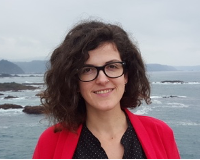Dr Davinia Fernández-Espejo
Supervisor Details
Davinia Fernández-Espejo’s main goal is to understand how the brain supports consciousness and what goes wrong for patients to become entirely unaware after severe brain injury. She uses techniques such as MRI (structural and functional), tDCS, and behavioural approaches in both healthy volunteers and patients with a disorder of consciousness to test hypotheses about the role of different brain structures in the clinical deficits they present. This research is directly translated into the development of diagnostic and prognostic biomarkers to be used in clinical settings, as well as the development of novel treatment approaches.
Research Groups
Project Details
Dr Fernández-Espejo is the supervisor on the below project:
Using multimodal neuroimaging to predict individual differences in responsiveness to non-invasive brain stimulation
Secondary Supervisor(s): Dr Magda Chechlacz
University of Registration: University of Birmingham
BBSRC Research Themes: Understanding the Rules of Life (Neuroscience and Behaviour)
No longer accepting applications
Project Outline
Non-invasive brain stimulation techniques (NIBS) such as transcranial direct current stimulation (tDCS) or Focused Ultrasound Stimulation (FUS) can successfully modulate neural excitability. It is possible to deliver tDCS and FUS safely in the MRI scanner, thus enabling us to interfere with and manipulate brain function while we record neural changes in real time. This allows us to establish causal inferences between changes in specific networks and resulting behaviour, with drastic implications in the fields of psychology and cognitive neuroscience. Moreover, NIBS has led to exciting new avenues for therapeutic interventions in psychiatric and neurologic conditions.
While there is vast evidence supporting that tDCS can modulate brain function and cognition, these effects are highly heterogeneous across subjects. Recent research has suggested that the variability in responsiveness to tDCS may arise from the effect of individual anatomical differences in the distribution of current across the brain. Indeed, there is evidence that cranial and meningeal thickness, volume of cerebrospinal fluid, and cortical folding can induce variance in electric field in neurotypical individuals. These effects are exacerbated in clinical populations where differences in brain morphology and microstructure are more pronounced (as a result of damage). Moreover, there is increasing evidence that differences in the functional state of the brain at baseline, and during stimulation, may influence subsequent responses to tDCS. While the literature on FUS applications is less mature, it is likely that individual differences in neural architecture will also modulate responsiveness.
The main aim of this PhD project isto understand and characterise individual variations in behavioural and neural effects of NIBS,and toidentify biomarkers that can predict whether an individual will be likely to respondto a particular stimulation protocol. There is scope to focus on tDCS and / or FUS. To fully characterise individual differences in neural architecture, the student will focus on advanced analyses of structural and functional MRI data (e.g., cortical thickness, tractography, and functional and effective connectivity at rest). The student will assess how differences in the neuroanatomy and function of specific networks modulate individual responses to stimulation. Specifically, they will pool metrics extracted from the above MRI modalities and test the power for different classification techniques (i.e., Support Vector Machines, and Deep Learning). Additionally, the student will explore the construction of Decision Tree classifiers. These provide explicit information about why the algorithm came to a particular classification decision and, thus, can have higher value in medical contexts, where justification can be very important.
This project will start with existing data, collected as part of an ongoing grant with the primary supervisor as PI (Medical Research Council [MRC]; 2017-2021). Additionally, the student will be able to test their methods in new cohorts of healthy participants as well of patients with severe brain injury.
Reducing the variability in responses to NIBS interventions by using protocols that are tailored to each individual will not only advance applications for investigating how different cognitive functions emerge in the brain but also increase the effectiveness of therapeutic interventions across neurologic and psychiatric conditions.
References
https://doi.org/10.1016/j.brs.2010.11.001
https://doi.org/10.1016/j.brs.2015.05.002
https://doi.org/10.1016/j.brs.2014.02.003
10.1016/j.clinph.2021.12.010Link opens in a new window
Techniques
- Structural magnetic resonance imaging.
- Diffusion Weighted Imaging.
- Functional magnetic resonance imaging (fMRI).
- Non-invasive brain stimulation (i.e., transcranial direct current stimulation and transcranial focused ultrasound).
- Advanced signal processing and statistical analyses.
- Computational modelling.
Dr Fernández-Espejo is also co-supervisor on a project with Professor Andrew Bagshaw.
Previous Projects
Previous projects can only be viewed by staff and students. Please make sure you are logged in to see this content.
